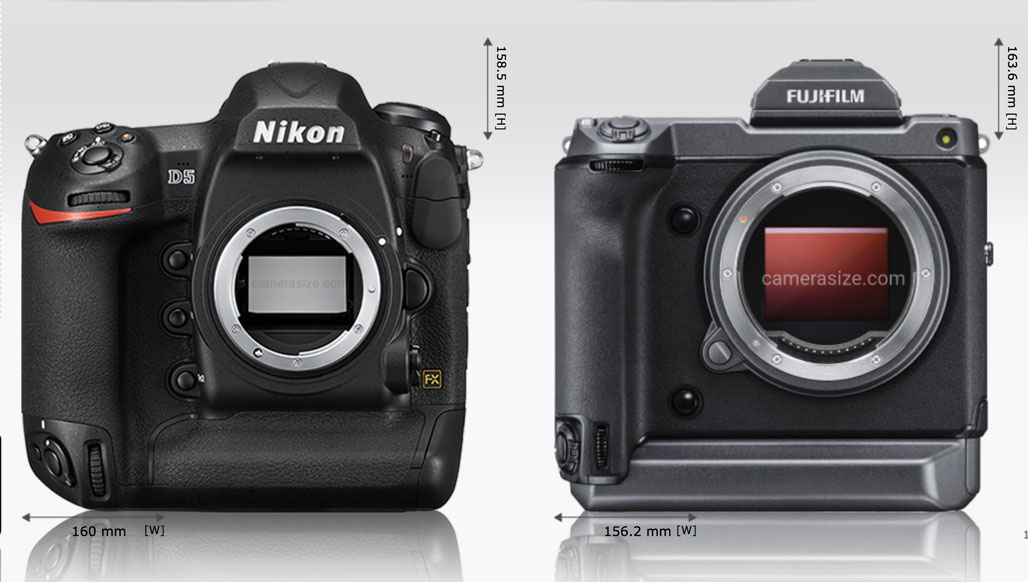Today’s Opinion from Joe Farace
Fujifilm’s introduction of the 102-megapixel GFX100 got me thinking about medium format and a post I wrote for my old blog called “What’s So Medium About Digital Medium Format?”
In the seventies, when I got serious about making photography a profession, I though I needed to own a medium format camera. My first cameras were a series of Mamiya TLRs that shot 120/220 film producing an image size of 6x6cm or as all the kiddies called it back in those days “two and one quarter-inches square.” I even made one of my favorite photos using a Mamiya C33. It was a wonderful format and when I graduated to a Hasselblad 500CM it also used the same 6x6cm format. I was finally a real pro, or at least I thought so at the time.
Well, these days everybody and their cousin seems to be making medium format digital cameras. In 2017, Fujifilm stole all the buzz from Hasselblad when introducing its GFX 50S. And with that introduction, we seem to have entered a golden age of medium format digital cameras or have we?

I’m sure this new breed of digital medium format camera are indeed fine picture taking machines much like the 500CM that I paid $666.67 (with 80mm T* lens) for in 1976; In today’s dollars that camera would cost $3,001. But this new breed is more expensive than that with prices ranging from ostensibly the best buy Pentax 645Z ($4996.95) to the ‘whoa mama’ Phase One XF IQ3 ($44,990.)
by comparison, the average price of a new car is $37,577, so I wouldn’t call these cameras medium priced although the $4996.95 price of a Pentax 645Z competes pretty well with a Nikon D5 costing $5,996.95. My friend Cliff says a more appropriate comparison is with Nikon’s D810 at $1,996.95 but I’m not sure I agree with him. So for a thousand bucks less than a Nikon D5 you get a camera with a 43.8 x 32.8 mm sensor instead of one measuring 35.9 x 23.9 mm. Better image quality? I’ll bet. Better low light response? Pretty sure. And get this, a Nikon D5 weighs 3.11 lbs while the Pentax weighs 3.42 lbs. Heck, the new Fuji GFX only weighs 3.08 lbs. And as far as size? I think the above photo tells the tale.
But perhaps a bigger question might be: Are these camera really medium format? Look at the list below that shows the sensor size and prices for some of the current crop of medium format digital cameras and decide if they’re medium format or have a sensor that’s just a little bigger than the 24x36mm film format Oscar Barnack created in 1925 with the Leica I.
- Pentax 645Z, sensor size 43.8 x 32.8mm, $4996.95
- Fujifilm GFX 50S, sensor size: 43.8 × 32.9mm, $5499
- Hasselblad X1D II 50C, sensor size 43.8 x 32.8mm, $5750
- Fujifilm GFX100, sensor size: 43.8 × 32.9mm, $9999.95
- Hasselblad H6D-100c, sensor size 53.4 x 40.0mm, $32,995
- Hasselblad H6D-400c, sensor size 53.4 x 40.0mm, $47,995
- Phase One XF IQ3, sensor size, 53.7 × 40.4 mm, $44,990
The 645 format that all of these cameras ostensibly use is actually quite old and during the film era was embraced by Bronica, Mamiya and Pentax among others. Those cameras used 120 film and produced 45 x 60mm images. A medium format Hasselblad, by comparison, created 60 x 60mm photographs. The redoubtable and bulletproof Pentax 6×7 produced images that measured 60 x 70mm, which is larger than any of the above digital medium format cameras, although the Phase One comes closest.
Am I going to get a Fujifilm GFX100? I’m tempted but the only thing stopping me is the price…and my empty wallet.
Update: Sony recently introduced the A7R IV with a 61-megapixel sensor that the company says delivers “medium format” quality. It has a full-frame (even if it doesn’t actually measure 24x36mm) sensor along with a 240-megapixel pixel-shift multi-shooting mode, which might appeal to some shooters. If I get a A7R IV to review, I’ll let you know how it shoots…
If you enjoyed today’s blog post and would like to treat me to a cup of Earl Grey tea ($2.50), please click here. And if you do, thanks so much.